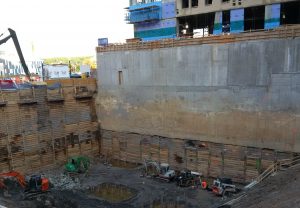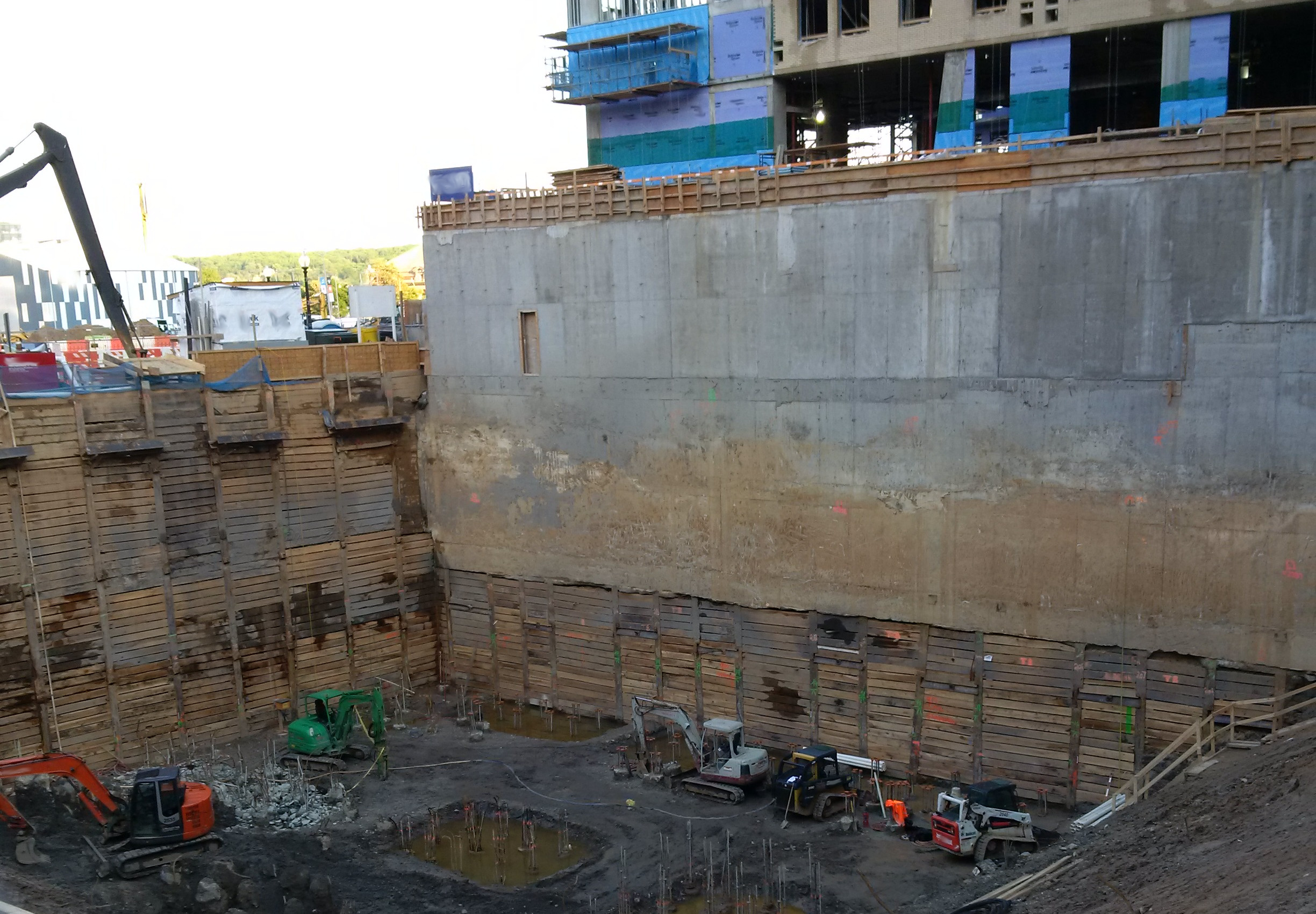 When structural systems are used to retain in-situ soil during excavation, the resulting soil pressures are difficult to accurately predict. In addition to the uncertainty inherent to soil materials, and the inability to fully measure those properties, the pressures on an excavation support system or permanent foundation elements that similarly retain in-situ soil and any existing facilities thereon are indeterminate soil-structure interaction problems. As the structural system is loaded, usually by the excavation of supporting soil, it deforms. Movement of the excavation support mobilizes the internal strength of the soil. For a given load, the deformation stops when equilibrium is reached and the soil and support structure are sharing the task of retaining the soil.
When structural systems are used to retain in-situ soil during excavation, the resulting soil pressures are difficult to accurately predict. In addition to the uncertainty inherent to soil materials, and the inability to fully measure those properties, the pressures on an excavation support system or permanent foundation elements that similarly retain in-situ soil and any existing facilities thereon are indeterminate soil-structure interaction problems. As the structural system is loaded, usually by the excavation of supporting soil, it deforms. Movement of the excavation support mobilizes the internal strength of the soil. For a given load, the deformation stops when equilibrium is reached and the soil and support structure are sharing the task of retaining the soil.
This loading process is non-linear, time-dependent, and is influenced by a number of soil attributes, as well as the configuration and behavior of the excavation support structure, both globally and locally. Consequently, there are many approaches to estimate the soil loads on an excavation support system, all of which are based on simplifying assumptions of the soil-structure interaction.
Some approaches are based on making assumptions about deformations and the relative stiffness between the support system and the soil. A distribution of soil pressures on the excavation support that can be used for design is derived from these assumptions. These approaches include the classical earth pressure theories and semi-empirical “apparent” earth pressure methods. The best known of these methods, the Rankine and Coulomb earth pressures are based on the assumption that the retaining structure moves enough to fully mobilize soil resistance such that the driving pressure on the structure is at its lowest value and resisting pressure at its highest value.
Other approaches incorporate estimates soil and structural system stiffness and use strain compatibility to apportion load between the soil and structure. These are the soil-structure interaction (SSI) methods. Sometimes the terms “soil-structure interaction” and the “finite element method” (FEM) are used interchangeably, but this is misleading. FEM is a means for solving equations numerically. A variety of different models can be implemented within a FEM package. In the context of SSI, this can include highly non-linear stress-strain relationships, adding considerable complexity. A simpler approach is based on the “beam-on-elastic-foundation” method by Westergaard, which replaces a continuous soil mass with closely spaced elastic “spring” elements. This approach can be implemented as part of the stiffness method of indeterminate structural analysis.
Engineers design excavation support systems and similar work often develop preferences as to how to solve these problems. A lot of engineers use earth pressure methods exclusively, due to their ease of use and low cost of design and find SSI to be an uncertain “black box”. Other engineers believe that no question can be answered without the use of FEM, despite the additional cost and potential risk due to complexity. Others cynically sell clients on FEM by exaggerating the accuracy of FEM solutions by displaying colorful software-generated plots.
All of the earth pressure and SSI methods all have advantages and limitations. None of them should be blindly applied to inapplicable problems. Using apparent pressure methods alone to design a deep cut on an urban site can result in excessive deformation, resulting in damage to adjacent properties. FEM-based methods require significant skill and care in model building and will produce poor results if problem geometry or input parameters are inaccurate or if meshing and boundary conditions are not properly addressed. These problems are often accompanied by overconfidence leading from the “precision” of the numerical approximation.
Choosing a design approach for an excavation support system is not always a simple matter and may greatly affect the cost and risk of construction. There are too many considerations to address them all in this space, but it is possible to identify the primary considerations in determining whether to approach the problem with an earth pressure or an SSI approach.
Deformations: A fundamental difference between the earth pressure methods and SSI is the computation of deformation. In SSI, deformation is computed directly from stiffness and the boundary conditions. Forces are then calculated from the deformations. Earth pressure theory allows computation of deformations to be skipped and forces to be found more directly. However, if deformations are needed later, they must be derived from the pressure diagrams and structural stiffness, usually leading to a much less realistic estimate. If you care about deformations – because the excavations support system has to prevent movement of adjacent structures and infrastructure, for example – then SSI is usually a better choice. But also note that as a matter of engineering mechanics, if the displacement of the system is unrealistic, the distribution of forces is also likely inaccurate. Thus earth pressure methods are usually less accurate overall.
Size & Importance: The size and importance of an excavation support system will largely drive whether a better estimate of deformations and forces from an SSI approach is warranted. Deep excavations will almost always violate the assumptions of the classical earth pressure theories and can be outside the empirical basis for apparent pressure methods. These methods may not provide a good estimate of excavation support behavior. The question is, what are the consequences? For deep excavations in urban areas, damage to adjacent structures and infrastructure is a significant risk. For permanent support systems, excessive movement can cause water infiltration and progressive collapse. SSI may be a good investment in these cases. However, for small, temporary excavations, where worker protection is the primary consideration, the added design cost and complexity of the SSI approach may not be offset by reduced construction cost and risk.
Quality of Data: SSI methods require additional parameters to model the stiffness of soils and structural elements and can be sensitive to values chosen due to the non-linearity of the model. Many of these parameters cannot be directly measured or specified, contributing uncertainty to the analysis. For the results of an SSI analysis to be useful, they must be based on adequate subsurface information, as well as a reasonably complete and accurate understanding of the excavation support system and loads from adjacent facilities
Design vs. Analysis: Design is an iterative process, and the design of an excavation support system is a sufficiently complicated problem that iteration is typically required. Most earth pressure methods do not require a complete a priori design. However, SSI is an analytical tool, requiring a relatively complete understanding of the problem to produce useful information. Since SSI almost always in a non-linear model, superposition does not apply. The analysis is typically performed at service load level and it can be difficult to evaluate strength limit states, second-order effects and extreme events from the results.
The decision of whether to use an earth pressure method or SSI method for design of excavation support should be driven by site-specific and project-specific factors like those I have described. Beyond this, the choice of a specific earth pressure distribution or SSI implementation needs to be considered carefully to avoid misuse. Having a one-size-fits-all approach is inappropriate and unnecessarily increase construction cost and risk. This decision is a task for experienced and knowledgeable professionals to make on each project.
The information and statements in this document are for information purposes only and do not comprise the professional advice of the author or create a professional relationship between reader and author.
